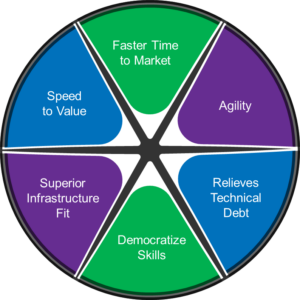Gen AI is the next big thing and business leaders are all ready to jump on the bandwagon. Gen AI is rapidly being adopted by IT leaders. According to Gartner, 73% of respondents to the 2024 Gartner CIO and Tech Executive Survey have increased funding for AI. Although Gen AI is the next big thing and adoption rates are gradually surging, organization are yet to prep and train their talents.
Business dynamics across the world have significantly changed in the last two years. Enterprises across the world have realized the critical need to rapidly digitize and address growing demand for enterprise apps and B2C apps that efficiently enable business and operations and accelerate speed to value while addressing the skill debt in the industry. Moreover, the Cloud disruption has increased accessibility and affordability of the latest technology and infrastructure which is enabling more and more businesses to rapidly focus on business innovation.
With the great talent crush across industries, the need for developers is still the more. Traditional application development and DevOps demand high developer skills continuously engaged in IT delivery. There is a need for a superior tool set and development environments. With moving goalposts, in the current scenario low-code development is becoming a game-changer. Low-code development allows developers to use visual components to build an application rather than going through a huge process to build an application. Meanwhile, Gen AI will further empower citizen developers by simply democratizing the coding process.
Low-code and Gen AI solutions are reinforcing business goals for digital transformation like never before. This amalgamation of low-code and Gen AI is coaxing businesses and IT to clasp hands together to weather the changing market dynamics.

So why should enterprises adopt low-code development?
The fundamental principles in which the Low-code, No-code systems are built include,
Collaboration between organization units in Application setup, configuration and implementation. These include Business, Development, Users etc.,
Relives technical debt resulting in superior speed to value
Skill availability, skills barriers and skill debts are addressed by democratizing the skills with visual application delivery, shifting of core development expertise to business knowledge, navigated configurations and customizations
The Cloud shift will greatly reduce the infrastructure limitations in the rapid product rollout
Seamless Integration, easy setup and deployment and more importantly pushing the boundaries to deliver speed to value.
How Cloud is a game changer in Low Code, No Code led business transformations
Cloud technology amplifies business transformation by allowing organizations to scale elastic infrastructure as needed to support changing business priorities. Moreover, Cloud is changing the way the applications are built and the true power of cloud is delivered through Cloud Native Development that is containers, Kubernetes clusters, serverless functions etc., However, building Cloud Native applications will demand a paradigm shift in the architecture, skilled resources and time, resulting in a huge investment.
“Low Code, No Code Cloud Native” systems can address these limitations using below advantages to drive the future for application modernization. Some of the key features of these systems include:
Templates driven Cloud Environment setup
DesignOps helps to integrate architecture designs into the workflows
Orchestration, integration and intelligence
Process automation
Built in cloud security
Talent fungibility
AI and Low-code – Comrades or combatants?
With boom of Generative AI, where does low-code stand? Top executives and analysts predict, it could go both ways for low-code. While some are of the opinion that a combination of Gen-AI and low-code can help set the path for advanced software development, some opine that it could end the low-code era and kickstart an era of high coding for developers. Based on Forrester’s most recent study, “87% of enterprise developers use low-code development platforms for at least some of their development work.”
Phasing out low-code from every aspect of the enterprise would not only add extra pressure on the development team but also create issues in the overall smooth BAU. Gen AI and low code will create the base to democratize development leading to faster time-to-market, scalability, flexibility etc.
Well, to see what the future holds for low-code applications, while Gen AI is being adopted swiftly, we should just hold on to our hats.








